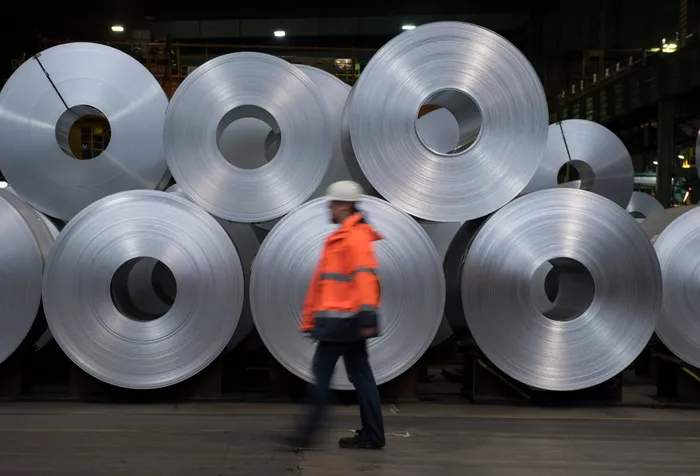Manufacturing output sees slight uptick in May, but economists raise concerns
MANUFACTURING

Nicolai Claassen, director of industry statistics at Stats SA, said the metals and machinery division was the largest positive contributor, expanding by 4.3% year-on-year and pushing overall growth higher by 0.9 of the percentage point.
Image: EPA
In a tentative sign of resilience, South Africa's manufacturing sector saw a 0.5% increase in production in May when compared to the same month a year earlier following six consecutive months of year-on-year decline.
This reading, released by Statistics South Africa (Stats SA) on Thursday, highlights a delicate turnaround following a tumultuous April which witnessed a significant production revised slump of 6.4% year-on-year.
Nicolai Claassen, director of industry statistics at Stats SA, said five of the 10 manufacturing divisions recorded upward growth.
Claasen said the metals and machinery division was the largest positive contributor, expanding by 4.3% year-on-year and pushing overall growth higher by 0.9 of the percentage point.
"Glass and non-metallic metal products, wood paper printing and publishing, textiles and clothing, and communication and professional equipment also registered a positive month," Claasen said.
"On the downside, five divisions were weaker in May. These were electrical machinery, the automotive division, petroleum, chemical, rubber, and plastic products, food and beverages, and furniture and other manufacturing not elsewhere classified."
The surprise rebound comes as South Africa faces tough trading conditions ahead after the Trump Administration imposed a 30% tariff on all products imported from South Africa, which is likely to result will be fewer exports, slower production, and inevitable job losses in the country.
Neil Roets, CEO of Debt Rescue, said tariffs of this magnitude will disrupt supply chains and shrink order volumes, placing immense pressure on these already fragile industries.
"From production to packaging and distribution, these sectors depend on stable global demand to support thousands of jobs. Tariffs of this magnitude will disrupt supply chains and shrink order volumes, placing immense pressure on these already fragile industries," Roets said.
"The manufacturing and agricultural sectors were expected to support growth and job creation in 2025, but the US tariffs could put that recovery on hold. Investor confidence may also weaken, and business expansion plans could be delayed or cancelled."
On a monthly basis, seasonally adjusted manufacturing production increased by 2% in May compared with April, representing the strongest month-on-month rise since July 2024 when production also grew by 2%.
Professor Waldo Krugell, an economist at the North West University, said it was tricky to know how to put the slight improvement in output in May into context.
“The PMI numbers have been depressed and a year-on-year improvement of 0.5% is rather flat. At least it is the second month of positive month-on-month changes.”
Meanwhile, Investec economist, Lara Hodes noted the modest increase in manufacturing output “came ahead of consensus expectations” that predicted a further decline of 1.4%.
Supportive of the mixed messages, history reveals that business activity has been subdued, continuing a grim pattern reflected in the seasonally adjusted ABSA Purchasing Managers’ Index (PMI) which remained in contractionary territory for a seventh consecutive month.
Hodes said the latest PMI results indicated that business conditions were still strained, with lower demand driving a decline in indices for business activity and new sales orders.
“The business activity and new sales orders’ indices remained subdued, well below 50, while the suppliers’ delivery index fell notably from 56.6 to 49.0. According to the BER, survey respondents’ comments imply that the decrease was driven by lower demand,” she said.
Despite these challenges, Hodes said there were hints of stability and improvement.
“Advance indications provided by June’s PMI release show that while manufacturing sector conditions remained subdued during the month they did pick up modestly, with global manufacturing conditions also improving somewhat.”
Nkosiphindile Shange, an economist at the Bureau for Economic Research, described the 0.5% increase as a "modest but meaningful shift," highlighting that it marks the first year-on-year growth in 2025.
Shange said analysts had expected a continuation of declines, forecasting anything from -1.5% to -0.5% production declines, but also noted that the sector was still facing subdued domestic and global demand and has excess capacity.
"This is the first year-on-year growth in production in 2025. The latest data is a welcomed development for the South African economy even if it doesn’t signal a full recovery," he said.
"Despite load shedding risks, weak demand, global trade uncertainty, and logistical issues, manufacturers still managed to improve output; the sector is very resilient. It shows capacity for adaptation and recovery even under stressful conditions."
BUSINESS REPORT